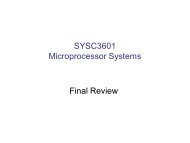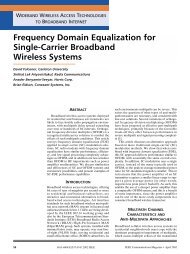Image Reconstruction for 3D Lung Imaging - Department of Systems ...
Image Reconstruction for 3D Lung Imaging - Department of Systems ...
Image Reconstruction for 3D Lung Imaging - Department of Systems ...
You also want an ePaper? Increase the reach of your titles
YUMPU automatically turns print PDFs into web optimized ePapers that Google loves.
Iteration 1<br />
(a)<br />
Iteration 4<br />
(d)<br />
Iteration 7<br />
(g)<br />
Iteration 2<br />
(b)<br />
Iteration 5<br />
(e)<br />
Iteration 8<br />
(h)<br />
TV<br />
L2<br />
phantom<br />
Iteration 3<br />
(c)<br />
Iteration 6<br />
(f)<br />
Iteration 9<br />
Figure 7.6: Pr<strong>of</strong>ile plots <strong>of</strong> the originating contrast, TV, and ℓ 2 reconstructions. No Noise<br />
added. Pr<strong>of</strong>iles are vertical slices through the middle <strong>of</strong> the reconstructed image.<br />
7.4.5 Parameters<br />
The PD-IPM method has two tuneable parameters β and λ. The value <strong>of</strong> β has a large<br />
effect on convergence. Too large a value <strong>of</strong> β (greater than 10 −6 ) prevented convergence<br />
to the desired “blocky” solution; the solution stabilized but showed smoothed features that<br />
were not consistent with the edges obtained with smaller values <strong>of</strong> β. Ultimately it was<br />
determined that the quickest convergence occurred when β was initialized to a small value<br />
(we used 10 −12 ) and left unchanged. This was the method used in the results shown in this<br />
paper.<br />
With an iterative algorithm multiple values <strong>of</strong> the regularization hyperparameter, λ,<br />
could be used <strong>for</strong> each iteration. In this work, <strong>for</strong> the TV algorithm, a different value was<br />
used <strong>for</strong> λ0, in the initialization step (7.40) and <strong>for</strong> λi in the iterative steps (7.38). λ0<br />
was selected using the BestRes method described in [52]. BestRes is an algorithm <strong>for</strong> objectively<br />
calculating the hyperparameter <strong>for</strong> linearized one-step EIT image reconstruction<br />
algorithms. This method suggests selecting a hyperparameter that results in a reconstruction<br />
that has maximum resolution <strong>for</strong> an impulse contrast. Although TV is not intended<br />
<strong>for</strong> use in imaging impulse type contrasts the first step <strong>of</strong> the algorithm requires solution<br />
<strong>of</strong> the quadratic problem. In previous work the BestRes algorithm has provided λ values<br />
based on an impulse contrast that has generalized well to non-impulse contrasts. See, <strong>for</strong><br />
108<br />
(i)





